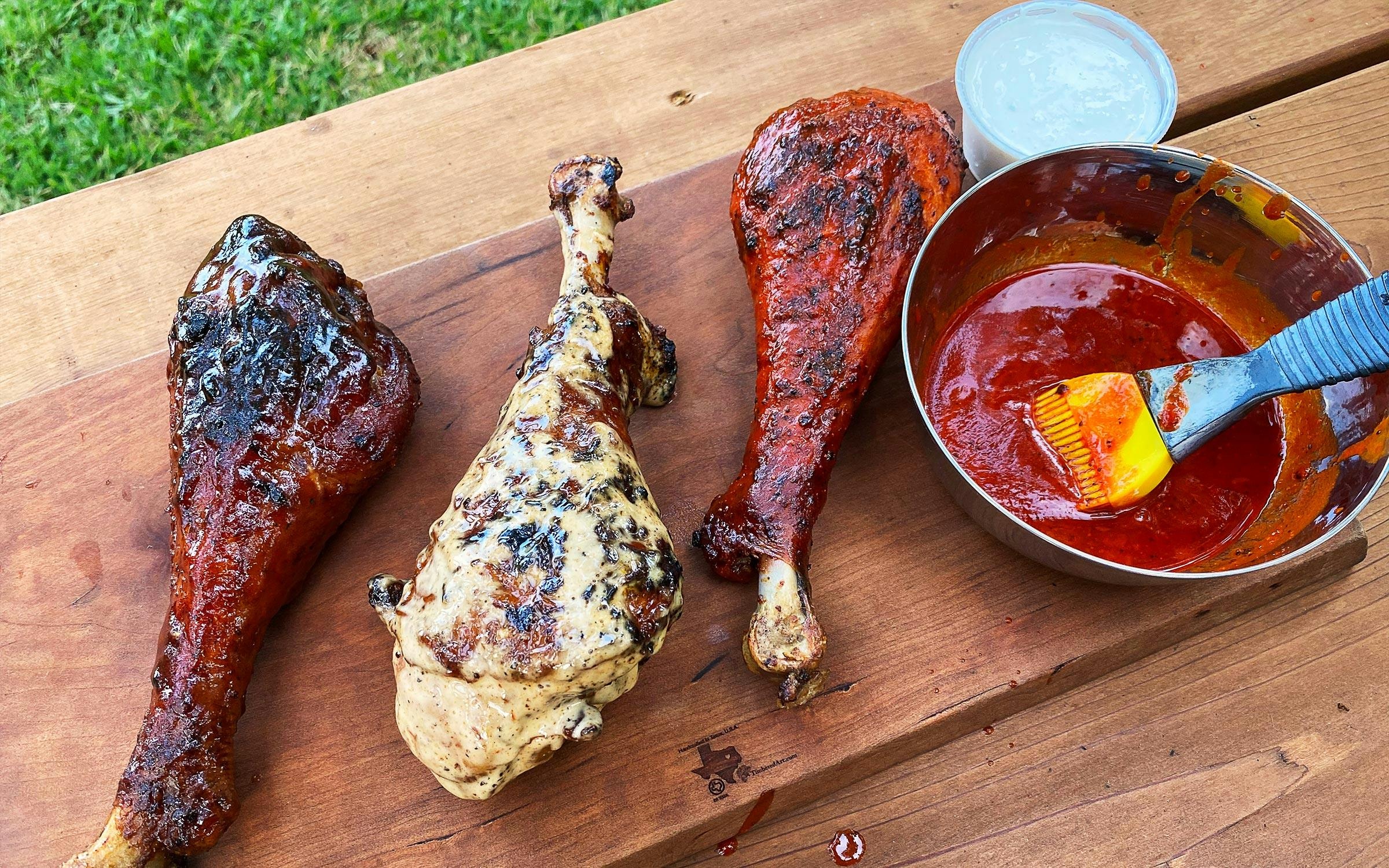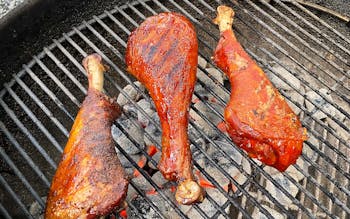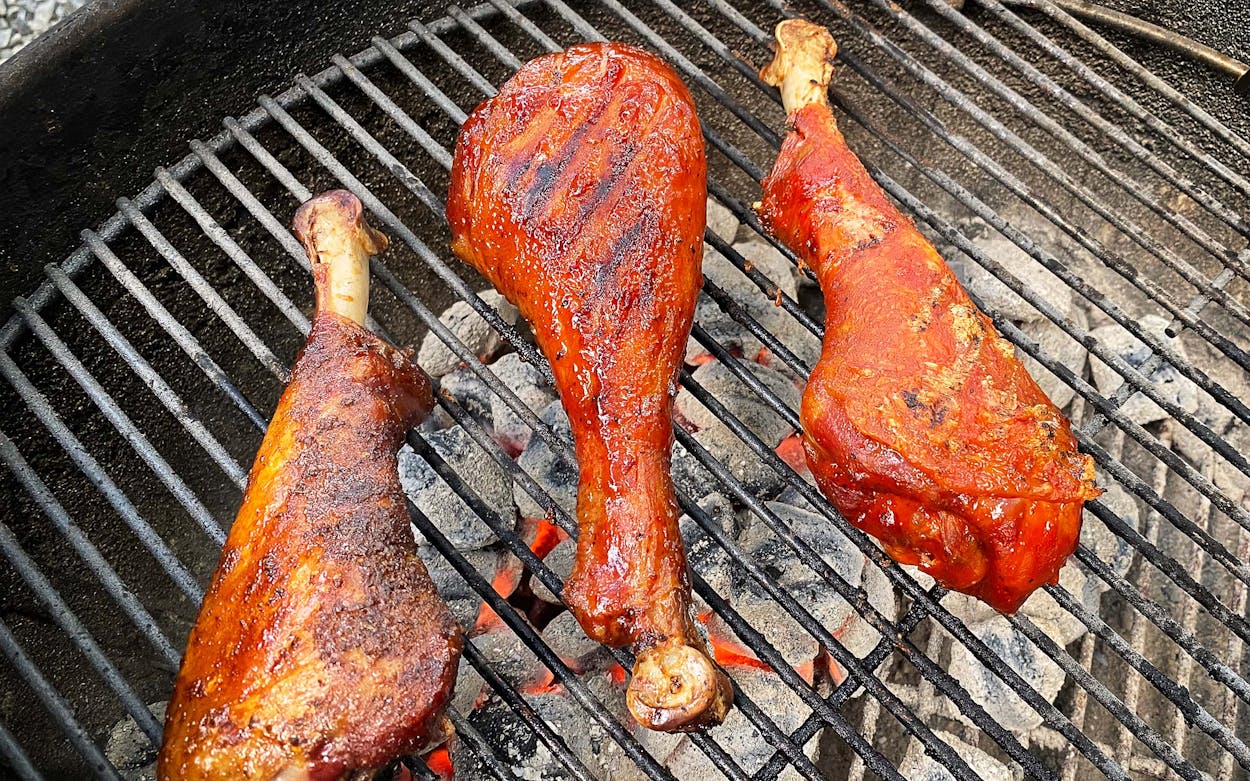I eat turkey legs about as often as I eat corny dogs, and they both happen at my annual visit to the State Fair of Texas. Sure, I might take a nibble from the Thanksgiving turkey leg, but my consumption was sure to be down this year with the fair being mostly canceled in 2020. The fair was originally scheduled to begin today, so I bought a half dozen turkey legs to smoke at home in celebratory solitude.
Turkey legs have become a symbol of carnivals, fairs, Disney World, and, I would assume, Medieval Times, though I’ve never been. It’s a protein-packed meat on a stick, best enjoyed outdoors in clothes that aren’t white. The problem is turkey legs can be really tough. There are lots of tendons and bones in that leg for meat to cling to, and most vendors don’t cook them long enough. As I’ve said before, the tenderness is what I like about the smoked turkey legs from the Smokey John’s Bar-B-Que tent at the State Fair. This year you can still grab one at the drive-through version of the fair, but if you’re not near Dallas, you can also make them at home.
The turkey legs from the grocery store were a bit smaller than the ones from the fair. Most all of those are supplied by Farm Pac in Yoakum. Their fully cooked legs are brined and smoked and weigh in at about two pounds each. The raw ones I purchased were about half that size. My goal was to serve tender turkey legs with crispy skin and plenty of smoked and salt flavor in the meat.

I didn’t want to wet-brine the turkey legs because dry-brining is simply better for crispy skin. I smoked two batches: one had been salted and left in the fridge uncovered for a full 24 hours; the other for just 8 hours. The extended drying and curing time really paid off in both flavor and texture. I applied a rub to both batches as well, and used oil on one batch to promote browning and allow the rub to stick better. The oil didn’t help with either, so skip it. Though I would recommend a toothpick securing the skin to the fat end of the leg during smoking to keep it from pulling back.
After seasoning, I fired up the smoker to 275 degrees. In just two and a half hours, the skin had pulled up from the bottom of the leg bone, and the meat was on its way to tenderness. To ensure they were pull-apart tender, I wrapped them in foil and put them in a 200-degree oven for an hour. Placing them in an empty cooler with a tightly fitting lid would also work.
For the final step, I went with the same method I prefer on homemade chicken wings: start slow and finish hot. I like my smoked wings finished in either the deep fryer or on a hot grill. I opted to grill these turkey legs for a final browning, and to get the skin super crisp. This also allowed me to brush on some of my favorite sauce. I settled on a trio of Texas Tang, a tomato-based barbecue sauce with honey, Burnt Ends spicy Alabama white sauce, and wing sauce. Any buffalo wing sauce will work, but I’ve been obsessed with the hot lemon sauce at Wingstop (this is not a paid advertisement), so I ordered a few sides of it and a tub of blue cheese for dipping.


Smoked Turkey Legs
Equipment
- 1 smoker
Ingredients
- 1 pound turkey legs, or as much as you’d like
- kosher salt
- barbecue rub
- barbecue sauce of your choosing
Directions
- Salt the turkey legs 24 hours or more before you plan to put them on the smoker, and leave them uncovered in the refrigerator. The following day, pull the turkey legs from the refrigerator before lighting the fire, then heat a smoker to 275 degrees. Once the smoker is heated, some moisture should have appeared on the surface of the legs. Sprinkle on your favorite rub evenly (I had success with both a savory and a sweet rub), but don’t apply a heavy coat. Smoke the legs for 2½ to 3 hours, or until the skin looks crisp and is pulled up from the base of the leg bone.
- Wrap the turkey legs in foil and move to an empty cooler with a tightly fitting lid, or place them into a 200-degree oven for about an hour. A little longer won’t hurt.
- Heat a grill for the final step. Place the turkey legs directly over the coals, and baste with sauce quickly. (As they do in Alabama, I held off on the white sauce during grilling, and applied it only afterward). The legs should be flipped every 30–60 seconds, depending on the heat of the coals, to ensure the skin and sauce don’t burn. Make sure all sides are well basted with sauce and well browned. This step shouldn’t take much longer than 5 minutes total.
- Remove the turkey legs from the grill and serve, or apply the white sauce if using it. That first big bite from the meaty portion of the leg is tempting and inevitable. After that, I enjoy pulling the meat from the bones(s) to get every last morsel.
















